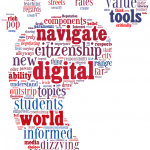As we organize our teaching/learning environments, it is important to hold time to learn ourselves – to challenge ourselves to engage with new ideas, to seek out new opportunities in professional learning, and to reflect how they relate with personal beliefs. This is about connecting to what is important. Only then can we bring powerful experiences for our students.
Here are some possibilities that might lead you to engage on different levels (contact any of our Learning Technologies team for more information or check out the sections in our blog):
 Blog or other online platform – Why? It’s all about communication and sharing your story, engaging the world (whether it is with parents or to a wider audience) in a dialogue of learning. Consider how Literature Circles, writing, interactive posters, audio radio shows, portfolios can all tell a story beyond paper and pencil. Start a positive digital footprint for students here.
Blog or other online platform – Why? It’s all about communication and sharing your story, engaging the world (whether it is with parents or to a wider audience) in a dialogue of learning. Consider how Literature Circles, writing, interactive posters, audio radio shows, portfolios can all tell a story beyond paper and pencil. Start a positive digital footprint for students here.
 Raz-Kids – Why? Reading fluency is foundational to solid reading practice. Students need to listen to good text and practice reading to gain proficiency. The ability to record personal readings multiple times, listen to hear themselves gives opportunities to self assess their own achievement.
Raz-Kids – Why? Reading fluency is foundational to solid reading practice. Students need to listen to good text and practice reading to gain proficiency. The ability to record personal readings multiple times, listen to hear themselves gives opportunities to self assess their own achievement.
 GAFE (Google Apps for Education) – Why? What’s the one thing that creates great writing – articulated revision comments in writing pieces (and lots of them over time). Google docs provides a seamless environment that connect comments to support the student writer as they grow in their ability to communicate in written forms. The collaborative nature of the application lends itself to focused writing and research projects.
GAFE (Google Apps for Education) – Why? What’s the one thing that creates great writing – articulated revision comments in writing pieces (and lots of them over time). Google docs provides a seamless environment that connect comments to support the student writer as they grow in their ability to communicate in written forms. The collaborative nature of the application lends itself to focused writing and research projects.
 Digital Citizenship – Why? Our students are growing up in a world where ‘digital’ is the norm. To some it is as ubiquitous as air. How do we harness this environment for learning? What added things do we need to consider in this world? While the ideals of citizenship and social responsibility are similar in both face-to-face and online environments, the online nature creates new challenges in understanding communication.
Digital Citizenship – Why? Our students are growing up in a world where ‘digital’ is the norm. To some it is as ubiquitous as air. How do we harness this environment for learning? What added things do we need to consider in this world? While the ideals of citizenship and social responsibility are similar in both face-to-face and online environments, the online nature creates new challenges in understanding communication.
 Fast ForWord – Why? Too often we try so hard to support our students who find reading incredibly challenging due to a host of reasons and we see minimal gains. Based on neuroscience and brain plasticity, Fast ForWord and Reading Asistant has offered significant learning success for these students. More information on this process can be found on our Fast ForWord blog.
Fast ForWord – Why? Too often we try so hard to support our students who find reading incredibly challenging due to a host of reasons and we see minimal gains. Based on neuroscience and brain plasticity, Fast ForWord and Reading Asistant has offered significant learning success for these students. More information on this process can be found on our Fast ForWord blog.
October is “Connected Educator Month”. How is this information connecting to your understandings? Please join us in the ongoing conversation and share with your staffs (send this link to them).